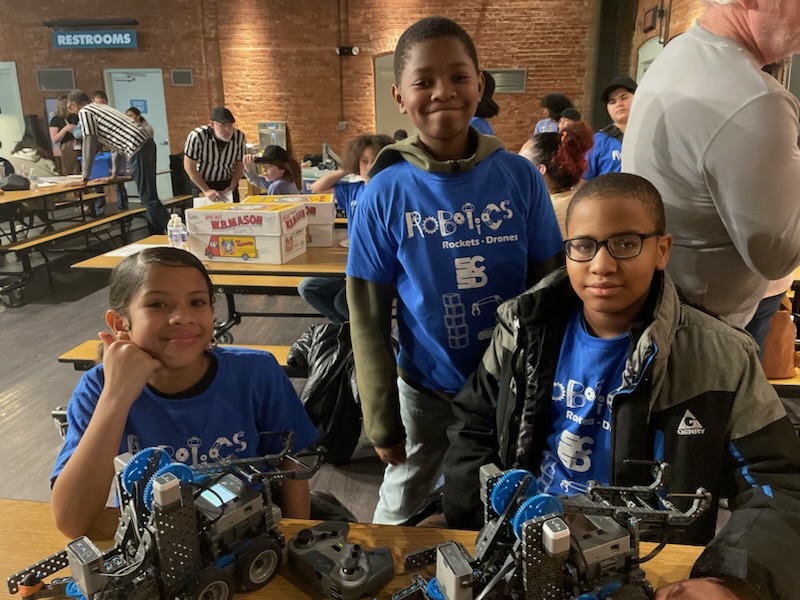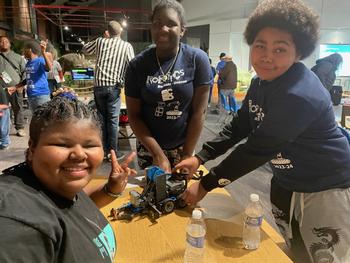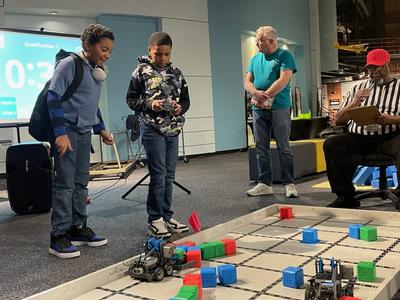After School Robotics Program Sparks Student Interest in STEM
Practical Benefits of Robotics
In 2015, Office of Family Engagement Attendance Coordinator Shalanda Graham helped partner former teacher John Betsy with staff at Ed Smith to start an after-school robotics group.
 Their goal? To expose inner-city students to STEM skills that would set them ahead in life. As time went on, John and his team slowly expanded the program – first to two schools, and now to 17 SCSD elementary and middle schools!
Their goal? To expose inner-city students to STEM skills that would set them ahead in life. As time went on, John and his team slowly expanded the program – first to two schools, and now to 17 SCSD elementary and middle schools!The programs are a true partnership – between the SCSD After School Program and community-based organizations including National Grid, Le Moyne College, the Westcott Community Center, the YMCA, Redhouse Arts Center, the Jim and Juli Boeheim Foundation, and more.
Based on 21st Century learning standards, the after-school robotics programs are free to students and include a full curriculum led by former teachers and STEM professionals. Units touch on the Engineering Design Process, an Introduction to Robotics, VEX Coding, Simple Machines, Pendulums and Pulleys, and more, wrapping up with a unit on aerospace and drones, as well as rockets.
Kathleen Garn is now in her second year teaching the after-school robotics group at Delaware Primary School – where she advises 4th and 5th grade students who join the program. For many, this is their first foray into robotics – and team dynamics.
“This program is beneficial because it teaches teamwork strategies,” Ms. Garn shared. “The students have to work as a team from start to finish. They work together to follow instructions to build the robots. Each team has 1 kit full of parts, and they follow step by step instructions to build the robot. The program also teaches patience, trust, and a sense of belonging. Each team member is beneficial to the production of the robot.”
Despite being fairly new to the world of robotics, in their first competition this year, the Delaware team brought home a second and third place win out of 12 teams!
“This program gives these students a sense of pride that I hope they will remember and take with them for years to come,” Ms. Garn added. “I have a few students that returned to my program from last year, and I even have some 1st and 2nd graders that tell me they can't wait until they're old enough to be in my class! It's just really special to be a part of something that gives these kids happiness and pride, and that also gives Delaware the respect it deserves.”
Fierce Competition
Over the course of the robotics season, there are three rounds of competition. In each round, several schools come together to compete – usually at the Southwest Community Center, the MOST, Syracuse University, or Le Moyne College.
In mid-March, students from Clary, Ed Smith, Grant, Roberts, and Syracuse STEM at Blodgett traveled to the MOST after school for their second competition of the season. There, 17 teams participated in 26 qualification matches – with only the top few teams facing off to determine the competition’s ultimate winners.

As they faced each other, standing on opposite sides of the playing field, the two teams of students each guided their own robot with the goal of collectively moving and stacking as many blocks as possible in 60 seconds. In between the qualification round matches, teams were also tasked with completing an individual Teamwork Challenge, in which their own robot moved and stacked as many blocks as possible within 60 seconds. A team’s total score from the two events would be factored into their overall score for the day.
“I love robotics,” Grant 7th grader Shafiqullah Baborai shared. “I helped design our robot. I worked with [school robotics advisor] Mr. Trujillo to design the robot and make it the most effective, and then I helped build it. The hardest part was actually building it – it took about two weeks. My favorite part is trying to program the robot so it can do things on its own… it makes me feel very bright! I’m always working to make my robot better in the future. I hope to be an engineer one day and I feel that robotics will help prepare me.”
Kaden Lemons – Syracuse STEM at Blodgett 6th grader has been participating in robotics since he was in elementary school.
“I’ve always had a thing for making stuff,” he shared. “It started out as just a fun way to go on field trips! At first, I wasn’t able to do much – I was just observing. But now, I’ve learned so much! The controls are the hardest thing to learn – things are almost reversed on them. But I love robotics. I love working as a team and trying to get the highest score!”
Preparing for the Future
School robotics advisors are staff members – all who are passionately engaged in helping students develop a love for STEM, as well as a confidence in themselves.
At Franklin, Wendy Mathews-Sisley is leading the school’s second group of robotics students – mainly 5th graders. As a math teacher who is really into computers, she said the opportunity to oversee the after-school robotics program was a no-brainer.
 “It’s such a great opportunity for the kids,” she shared. “We’re building kids’ creativity, getting them interested in STEM. I definitely see them becoming better problem solvers, becoming leaders within the room.”
“It’s such a great opportunity for the kids,” she shared. “We’re building kids’ creativity, getting them interested in STEM. I definitely see them becoming better problem solvers, becoming leaders within the room.”Ms. Mathews-Sisley noted that after she was absent for a few days, she heard from a substitute that students came in for their robotics meeting, got the field set, and participated in their practice.
“They taught the substitute how to do robotics!” she recalled. “They are gaining those skills that are going to make them successful in life. Some of my students, when they first started, weren’t confident that they were going to get better. Now, they’re more confident. There’s a lot of personal reflection. Each week, the students write their own goals, and they evaluate how they’re improving as they work toward them. These are skills they’ll need to learn as they enter middle school.”
She also noted how the after-school offering has offered a low-pressure option for younger girls to discover a passion for STEM.
“I love seeing our girls get interested in robotics,” she added. “They aren’t often given opportunities like this. Some of my girls were really looking forward to doing robotics when they got to middle school, and they’re so excited to find out we have it here. We have a good balance of girls and boys, but sometimes, our girls are less confident when they start out. I tell them: you are just as good as the boys – you can be better than they are… and they rise to the challenge!”
At Grant Middle School, Science teacher Eliseo Trujillo, now in his third year leading the after-school robotics program, said his students have a unique advantage when it comes to skill-building to benefit them in the future: programming.
Robotics organizers note that at the elementary and middle school levels, it’s uncommon for students to be familiar with the advanced concepts required of programming a robot. But for Mr. Trujillo, it’s a priority.
“One of our best skills here is programming,” he shared. “I like it, and I like to teach it! It’s easy to learn how to build and operate a robot but the programming is the part where you really have to think. All my students know how to program. From the first day, I teach them how to code. They build the robots, they code, then they learn how to program them.”
Grant robotics students have learned to use their robot creations to do more than just compete: they have even adapted some tools to allow robots to help with plant harvesting! Mr. Trujillo, who has a background in plant science, has shown students how to transplant seeds, grabbing them with the robot arm and planting them in soil. He’s even gone so far as to grow plants on the school roof – showing students how to fly a drone over the top of them to provide fertilizer. These are true skills of the future, Mr. Trujillo insists.
“You can program robots to do so many tasks,” he explained. “I teach coding and programming so we can mix these skills. It’s important! Artificial intelligence is coming. Who’s going to program those things? Who’s going to code them? We need engineers who are trained to do that. It’s my passion. It’s also a great opportunity for the students to apply something that they can actually do. I tell my students they can build a robot in a week. Then what? You’re just going to drive it? I want them to learn something that has no limits. You can program whatever you want. Sometimes, they program things that I would never have thought of – it’s an open-ended field. You can go as far as you want. If they pursue that, they can do amazing things. This will open those doors for them.”
Thank you to the committed students – and staff – who dedicate their time each day after school to developing a love for science, technology, engineering, and math!


